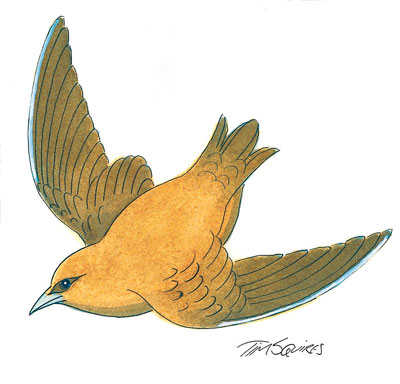 The final piece of the summer jigsaw was put in place over the Christmas period when a party of dusky woodswallows came into view in the Tamar Valley.
The final piece of the summer jigsaw was put in place over the Christmas period when a party of dusky woodswallows came into view in the Tamar Valley.
It proved to be a magical day, sealing what had been a magical year in a setting that only Tasmania could offer.
The round of family visits had taken us first to the Eastern Shore in Hobart and then north to Launceston. As usual, I had kept an eye open for birds on my family’s travels: musk lorikeets in Howrah and sooty oystercatchers on Howrah Beach; a wedge-tailed eagle being harried by brown falcons on the way north at Austin’s Ferry and pelicans on the Tamar River in central Launceston before we reached our northern destination, my wife’s sister’s home near Grindleward.
All the time on our travels I had looked for the one common migrant to evade me all summer, the dusky woodswallow. With my son at the wheel of our car I had not seen them at a spot on the Midland Highway where I often find them hawking insects, at Spring Hill, nor in the eucalypts lining the road through Epping Forest further north.
Reaching our destination I was drawn irresistibly to the view from my sister-in-law’s home, that follows the snaking Tamar north at it widens through the steep sides of the Tamar
Welcome swallows that nest under the deck of the home chased insects in the summer sunshine before swooping to a lake lower down the valley to drink on the wing from its still waters. I could see the gentle ripples as the swallows touched the water and then returned to their feeding, snapping at insects to bring them up the valley to young ones in their nest.
Between family talk and a fine Boxing day lunch I kept returning to the main windows, not just to look for birds but to admire the view. Down south we speak of our Derwent, but the Tamar remains largely an unsung attraction to us southerners.
By late afternoon the sun had etched in shadow not only the features of the valley, but the hedgerows and vineyards that slope to the river’s shores at the valley floor.
Now below me the tight lines of vines were striped in dark and green light, in gentle curves as the vineyards followed the contours of the lower valley.
Across the river, the bell tower of the 170-year-old St Mattias Church at Windermere caught the yellow sun, and was framed between what looked like oaks from afar. It could have been a scene from a country district of my home country of Britain.
And all the while the chatter of birds floated through the air. Continuing the English theme, goldfinches sang in the vineyards (it is no a coincidence a flock of goldfinches is called “charm” in Britain) and from further up the valley the flute-like calls of magpies sounded through the wattles and gums.
By now I had forgotten about dusky woodswallows, but a passing trio of black-faced cuckoo shrikes, my second-to-last bird of summer spotted a month previously, reminded me that the woodswallows were still missing from my list.
And then in a flash I saw one sweep by, in straight direct flight, the dusky, bluish sheen to its plumage, and its white-tipped tail, clearly visible. Only a fleeting glimpse, but an unmistakable sighting all the same because woodswallows – more closely related to members of the magpie family than true swallows – are easily identified by their bulkier form and less agile flight patterns.
Summer was complete.